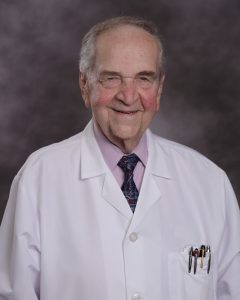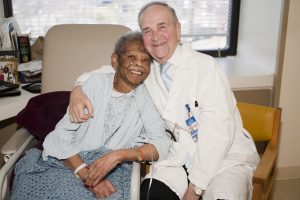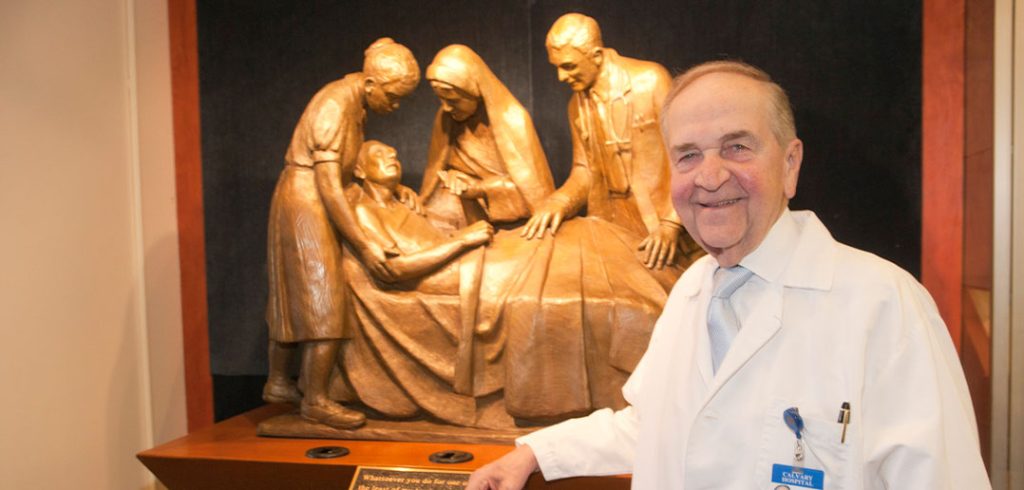Brescia was born in the Bronx on January 11, 1933, and grew up in a small apartment in the borough with his parents and three sisters. “I slept in the living room on what’s called in Italian a branda, a foldout bed, that was kept in the closet when it wasn’t used,” he said in the book Just Kids from the Bronx (Holt, 2015).
His father, a public housing superintendent, hoped that his son would find a lucrative career as a plumber. But one day when Brescia was a boy, a well-dressed physician made a house call to their building.
“There was a lot of talk and excitement about this guy, this doctor,” Brescia recalled. “I was absolutely awed and said, ‘That looks like something I’d like to be.’”
Creating a Revolutionary Medical Procedure
Brescia enrolled at Fordham in 1950, becoming the first member of his extended family to go to college. Four years later, he earned a bachelor’s degree in biochemistry from Fordham College at Rose Hill.
“He adored Fordham and the education the Jesuits provided,” said his son Christopher Brescia, who added that his father always wore his class ring. “His love of Fordham was so contagious that five of his nieces and nephews and one granddaughter graduated from there. Ultimately, it was the combination of the spiritual and intellectual excellence of Fordham that propelled him through his entire career.”
 He followed his time at Rose Hill by earning an M.D. from Georgetown University in 1958 and completing his medical residency at a Veterans Administration hospital in the Bronx. It was there that he and another physician, Dr. James Cimino, developed a technique to improve kidney dialysis.
He followed his time at Rose Hill by earning an M.D. from Georgetown University in 1958 and completing his medical residency at a Veterans Administration hospital in the Bronx. It was there that he and another physician, Dr. James Cimino, developed a technique to improve kidney dialysis.
At the time, patients could be kept on blood-cleansing dialysis machines only for limited periods of time before risking severe damage to their arteries, among other side effects. Brescia and Cimino discovered a way to stitch an artery and vein together that allowed them to safely and repeatedly use the same location on the body to move blood between the patient and the machine.
That lifesaving breakthrough, known as the Cimino-Brescia fistula, was seen as a source of huge potential profits, and the doctors began dealing with investors to set up dialysis centers around the country. As the contracts sat in legal limbo, though, Brescia said his father encouraged him to give it away. If he didn’t, he said he would be haunted by “the faces of the children … who should be with their parents,” Brescia told Fordham Magazine in 2016.
He and Cimino decided to publish their findings in The New England Journal of Medicine in 1966. Brescia later said that he never made money from the technology. “We took a road. To the left, it looked shiny and gold. But to the right, it looked happier to us.”
An ‘Individualized Approach’ to Palliative Care

In 1962, Brescia, along with Cimino, began working at what was then known as the House of Calvary, a nonprofit medical facility founded in 1899 by a group of widows to care for women in poverty with terminal illnesses in Greenwich Village. By the time Brescia arrived, it had moved to the Bronx and was sponsored by the Roman Catholic Archdiocese of New York.
In the years that followed, with Brescia as attending physician and Cimino first as chief of medicine and later as medical director, Calvary became fully accredited. It was renamed Calvary Hospital in 1969 and moved to its current location on Eastchester Road in 1978. Brescia was named executive medical director in 1994. Today, Calvary is widely regarded as a leader in end-of-life care, with a mission “to serve where the need is greatest among those who suffer most,” Brescia once said, “to equally relieve their physical, emotional, and spiritual pain.”
Joseph M. McShane, S.J., president emeritus of Fordham, recalled working as an orderly at Calvary in the early 1960s, when he was a Jesuit novice.
“I well remember my time there,” Father McShane said, noting that all novices in what was then the New York Province of the Society of Jesus were required to work at Calvary for at least a month as part of their training. “It was a time of great grace for all of us. As one of the nursing sisters at the hospital told us when we arrived, ‘God walks the halls around here—24 hours a day.’ She was right.”
For Jessica Morales, FCRH ’97, who slept on a cot in her mother’s room at Calvary for months while she was being treated for aspiration pneumonia, that presence of God was evident in the kind of care her mother received.
“The care there was so different from the beginning,” she told Fordham Magazine in 2016, noting that hospital staff turned her mother in her bed every two hours, brushed her hair the way she liked, and played her favorite Mexican music to soothe her. “It was an individualized approach.”
“Every time we have a meeting here, everybody’s hugging,” Brescia said. “You have to touch your patients. You have to hold their hands. And it’s got to mean something to you.”
A Lasting Legacy at Calvary, Fordham, and Beyond
The kind of palliative care Brescia and his team offered at Calvary Hospital made him a natural fit to return to his alma mater, which he said gave him “the gift of faith.”
He came back to campus to speak with students and faculty, including at a 2015 symposium titled “Humanizing Medicine: The Achievements and Future of Palliative Care.” Fordham students and faculty have also conducted research at Calvary, and other Calvary medical staff have lectured at the University.
“I was fortunate to hear a couple of presentations by Dr. Brescia,” said Cathy Berkman, Ph.D., director of the palliative care fellowship program at Fordham’s Graduate School of Social Service, which has seen a number of its students and graduates take internships and jobs at Calvary. “It was clear that I was in the presence of a very special physician. The concern, and I think love, that he had for patients at Calvary was so deep and genuine. I know many excellent and dedicated health care professionals, but Dr. Brescia stands out as someone we can all admire and hope to emulate.”
In 1994, Fordham awarded Brescia an honorary doctorate of humane letters. The citation in that year’s commencement program reads in part, “He helps the sick lead productive lives; he leads the dying into the vestibule of heaven.”
Brescia is survived by six children—three of whom are physicians—and nine grandchildren. His wife of 53 years, Monica, died in 2007 of a brain aneurysm.


